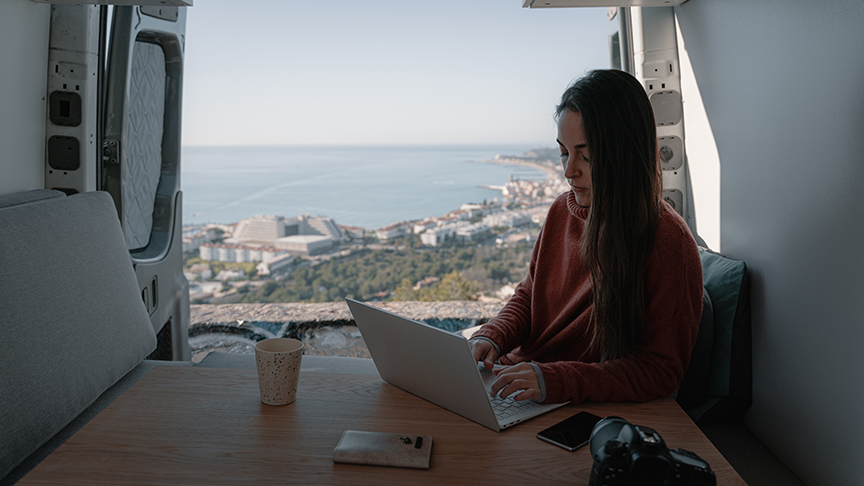
Today, having an encrypted connection is more important than ever.
In a world where we must constantly be on guard about…well, everything, that also means taking extra precautions regarding our Wi-Fi connection, especially on the road. While it may seem convenient to use public campground Wi-Fi, you are making yourself vulnerable to session hijacking, man-in-the-middle attacks, and “evil twin” attacks, all putting your sensitive data accessible to others.
Luckily, you can use a trustworthy VPN to create a “private tunnel for your online activity, encrypting your data…from the prying eyes of neighbors, hackers, internet service providers (ISPs), and even governments,” says Pete Nicoletti, chief information security officer at Check Point Software Technologies. Here’s how you can use a VPN to protect yourself and those around you.
- Pete Nicoletti, chief information security officer at Check Point Software Technologies, contributed expertise to this article.
- This article was reviewed for accuracy by Jeff Gwinnell, connectivity specialist at TravlFi.
What Is a VPN and How Does It Work for RV Wi-Fi?
Basic VPN Functionality Explained
A VPN—or virtual private network—encrypts the data sent and received between your device and the server, essentially “hiding” your activity and IP address from others. This could include others on a public Wi-Fi network or hackers waiting for you to visit a sketchy website.
Differences Between VPN Use at Home and on the Road
VPN setup and usage at home versus on the road operate similarly, according to Nicoletti, but generally serve different purposes. On a home router, you might use a VPN to protect yourself from your ISP (internet service provider). Because you aren't likely to encounter hackers on home Wi-Fi, ISPs are the next biggest threat as they can track all online activity and potentially sell that information to advertisers.
On an RV router, however, a VPN will protect you from public Wi-Fi sources or potential predators on the websites you visit. This is especially important since additional vulnerabilities exist when you move often and connect your router to a multitude of different servers.
How to Set Up a VPN on Home Wi-Fi vs. RV WiFi
Choosing the Right VPN Provider
When choosing a VPN, Nicoletti emphasizes the importance of finding a provider with a large number of server locations because, especially when moving from place to place, you will be connected to a server that is closer to you which may help connection speeds. He also recommends looking for a VPN with a high throughput speed—the amount of data that can pass through a network in a particular amount of time—to ensure a speedy connection.
Another VPN safety feature includes a kill switch, which automatically disconnects your devices from the internet if the VPN disconnects—this ensures that there is zero chance for data to be seen unencrypted.
It is generally best to avoid free VPNs as they may track or sell your data to third-parties. Instead, look for VPNs that enforce strong security and privacy protocols, like WireGuard or OpenVPN.
Installing a VPN on Your Router vs. Individual Devices
Most commonly, people install VPNs on individual devices to protect that device from hackers and malware, but installing a VPN on your router can offer some additional benefits.
Pros of Installing a VPN on Your Router:
- All connected devices will automatically receive VPN protection, even those of your guests.
- You don’t need to remember to turn your VPN on, minimizing accidental periods of unencrypted connection.
- Devices that do not directly support VPN installation are still covered.
Cons of Installing a VPN on Your Router:
- The proximity of your VPN protection is limited to your RV.
- Connection speeds may decrease.
Pros of Installing a VPN on Your Individual Devices:
- Devices used away from the RV router can still receive VPN protection.
Cons of Installing a VPN on Your Individual Devices:
- You must install the VPN on each device you wish to protect separately.
Step-by-Step VPN Setup (Router-Based)
According to Nicoletti, each router has a unique way to navigate to the configuration screen, but usually, the configuration screen will be found by entering the router’s IP address into a web browser.
Then, you will provide the admin name and password. “It is critical to change your admin name and password during initial configuration, as hackers will attempt to access your device through default passwords,” he warns. Next, you must find a VPN panel page and select your VPN provider; from here, each VPN software will walk you through configuration.
Once your VPN is configured to your router, test the speed to make sure it is working effectively. Some smart TVs can run a bandwidth test, but Nicoletti says the “gold standard” test is the Speedtest by Ookla which can be conducted on laptops and cell phones.
Psst: TravlFi’s XTR and XTR Pro 5G routers have the capability to work with certain VPN protocols, says Jeff Gwinnell, TravlFi connectivity specialist. However, “The setup is advanced for most people and requires knowledge of device settings, IP addresses, and other elements based on the service in use.” For that reason, TravlFi typically recommends software-based VPNs for most people.
Step-by-Step VPN Setup (Device-Based)
Setting up a VPN on individual devices may seem less daunting than on a router and is often as simple as downloading your VPN provider’s app from the app store on your device. Then, make an account, and allow the app to configure itself on your device.
To manually configure a VPN on phones, tablets, and computers, go to your device settings and find the VPN panel (for example, “VPN & Device Management” on iPhone and iPad). From there, simply enter your VPN provider’s credentials, and you're protected!
Device-based VPNs may be more suitable than a router-based setup for those who are using a VPN to wiggle around geo-restricted content—it is much easier to switch your server with a VPN on your mobile device than a router.
For example, some movies and shows that are not available on American Netflix may be available on Canadian Netflix, so VPN users may switch their server location. The biggest benefit device-based VPNs have over router-based VPNs, however, is that even when you are away from your RV, your device still receives an encrypted connection on the go.
Building a Secure RV Wi-Fi Network from the Ground Up
Hardware You Need
- Signal boosters, like one from the brand Winegard that TravlFi carries, work by harnessing the existing signal and reamplifying it in a concentrated area like your RV. This makes your Wi-Fi experience more secure by minimizing your need to connect to sketchy public Wi-Fi networks.
- Ethernet cables, Nicoletti says, may help streamline your connection between device and router in RV parks with congested Wi-Fi. Not only can a physical connection improve your connection, it can prevent accidental connection drops which may be extra important if your VPN does not have a kill switch.
Choosing the Right Data Source
Nicoletti notes that the least secure data source is public Wi-Fi. Private home Wi-Fi and Starlink become safer, but cellular data is the most secure.
The data source matters for your security because it determines who has access to your connection. Public networks, especially ones that are not password-protected or have weak security protocols, leave you exposed to the network owner or hackers whereas cellular communication is only able to be intercepted by law enforcement, according to Nicoletti.
Secure RV Wi-Fi Best Practices
Using a VPN is already a greater way to secure your RV Wi-Fi, but make sure you check your router and VPN provider for updates frequently. Although it may not seem urgent, updates ensure that your devices receive security patches and performance improvements.
FAQs
Can I use a VPN with Starlink or mobile hotspots?
According to Pete Nicoletti, Starlink routers do not directly support VPN software, but there are ways to work around this. You can enable bypass mode on your Starlink and connect it via ethernet to a VPN-compatible router which will become your Wi-Fi access point, he says.
If you are using your VPN-protected mobile device as a hotspot, however, devices connected to it will not receive VPN protection unless they, themselves, have a VPN. According to Gwinnell, “Hotspots and phones are not designed for more advanced operations such as working with VPNs.”
Will a VPN slow down my RV internet?
A VPN may negatively impact the speed of your RV router since all device data must go through an encrypted tunnel, but according to Pete Nicoletti, chief information security officer at Check Point Software Technologies, prioritizing a VPN with a large number of server locations will help combat this because you will be connected to a server closest to you. A VPN is an important security tool, so if your connection speeds slow down, it may still be worth keeping your VPN to protect your sensitive data.
What’s the easiest way to secure my RV Wi-Fi?
Configuring a VPN to your router is an easy, effective way to secure your RV Wi-Fi. Usually, setup is a simple matter of entering your router’s IP address into your web browser, navigating to the VPN panel, and entering your VPN credentials. A router with trustworthy VPN software will ensure all devices connected receive VPN protection, even if the individual device does not support VPN capabilities.
More Essential Reading for Digital Nomads:
- Is RV Wi-Fi Any Good? RV-ing Experts Dish Out the Truth
- Starlink and T-Mobile Say “No More Dead Zones”—Here’s What That Means for Off-Grid Travelers
- An RV Internet Expert Shares Tips for Optimal RV Wi-Fi Setup
- Ditch Your Phone Hotspot: The Real Difference Between a Mobile Hotspot vs Phone Hotspot for Traveling
- The 4 RV Wi-Fi Options Every Digital Nomad Needs to Know About
Learn more about the ways you can stay protected and connected with TravlFi.

Article By: Ever Vigee
Ever Vigee is an award-winning writer and digital advertising student at Louisiana State University. A member of the LSU chapters of The National Association of Black Journalists and the American Advertising Federation, she grew up surrounded by creativity and enjoys expressing her ideas through graphic design, writing, photography, fashion, and music. Ever strives to be an effective communicator and is eager to travel and explore the world in ways that will supplement her creativity and understanding of different cultures.
